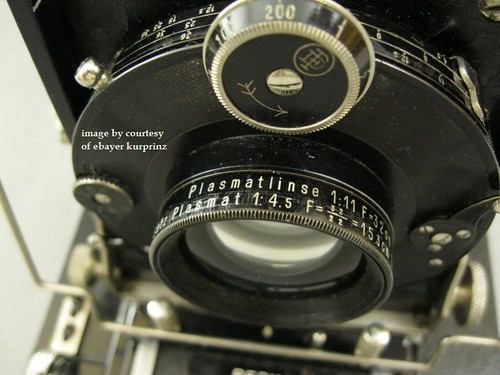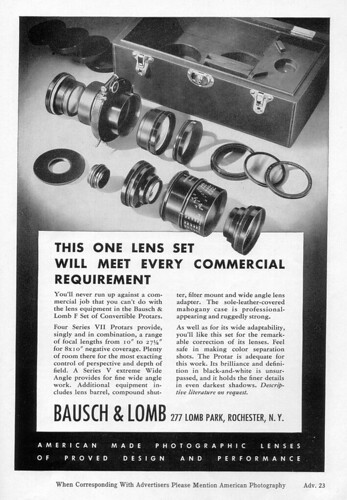Convertible lens

|
| A convertible lens's inscription: focal length 32cm for Plasmat lens only, or 15.3cm for complete Plasmat lens set. Futher inscription: D.R.P. Dr. Rudolph Hugo Meyer image by ebayer kurprinz (Image rights) |
A convertible or combinable lens is a lens consisting of two or more separable groups of glass elements, some of which can form an acceptable image when used on their own.
100 years ago these lenses were a common option for photo amateurs to give a double or triple extension folding camera more versatility. Some common lenses of that era consisted of a pair of lens tubes, one to screw into the back of an aperture/shutter-unit, the other to be screwed into its front side. Mounted that way the lens elements of both groups combined to make up the complete standard lens, usable with single extension of the camera bellows. These lenses are often, but not always, near-symmetrical double-anastigmats, and one half of the lens can be used alone (usually the rear half). This has a focal length roughly twice that of the two halves used together (and therefore a relative aperture about half as great).[1] It also requires more bellows extension to achieve any focus distance, so is particularly suitable for double- or triple-extension cameras.
It is possible to separate the parts of lenses as simple as a Rapid Rectilinear, in which each half is just two glass elements cemented together. Some non-symmetrical lenses can also be used this way: the front (cemented) group of a Petzval lens can be used alone, if fitted behind the diaphragm.[2]

|
| 1939 advertisement for Convertible Protar in a set with appropriate iris diaphragm shutter, made by Bausch & Lomb. A convertible Protar variant was also offered by Zeiss. scanned by Geoff Harrisson (Image rights) |
At the end of the 19th century, lens makers sought to exploit this ability of lenses more fully. Some makers designed symmetrical lenses in which each half was well-designed to be used alone (i.e. chromatic aberration and other faults are well corrected in one half of the lens; symmetrical lenses often depend on the use of both symmetrical halves to correct chromatism etc.). Examples are the Zeiss Protar Series VII (the two half-lenses together are a Series VIIa), the Ross Combinable, and the Goerz Pantar.[3]
Because such groups are well-corrected on their own, it is possible to combine front and rear groups of different focal lengths: with these sophisticated convertibles it is possible to exchange the front group while leaving the same rear group mounted, giving a greater choice of focal lengths. Such a system was later used in a few 35 mm SLR cameras; the Contaflex (beginning with the Contaflex III) in the 1950s, and the Canon EXEE and EX Auto of the 1970s. Because these are rigid-bodied cameras, it is not possible to use the rear group on its own as in a bellows camera, though it is capable of forming an image, because it is fixed too close to the film plane.
Combinable lenses often comprise fully cemented groups of three, four or even more elements. This required them to be ground to more than usually close tolerance, and they were therefore expensive to make,[3] and rarely used for popular cameras.
Some modern compact cameras use a similar idea; they have a double-focus lens instead of a single-focus or zoom lens. In most cases the focus switch of such cameras shifts one lens element into or out of the lens tube.
Notes
- ↑ For example, Early Photography shows a quarter-plate Verto camera by Adams, with a 5½-inch f/5.5 Ross Combinable; with the front group removed, the rear group is a 9½-inch f/11 lens. The camera has infinity stops for each arrangement.
- ↑ Lenses article at Early Photography.
- ↑ 3.0 3.1 Greenleaf, Allen R. (1950), Photographic Optics Macmillan, New York.
Links
- Meyer f/5.5 Doppel-Plasmat Set for 13×18 cm format, comprising a fixed front component (focal length not specified, but must be about 22 cm) and interchangeable rear components of 26 and 32 cm, both f/11. Sold at the 20th Westlicht Photographica Auction, on 1 November 2011.
- Meyer Euryplan Satz-VI, again comprising a fixed 366 mm front component and three interchangeable rear components, of 314, 262 and 209 mm. The aperture is marked in absolute diameter, not f-stops. This lens was also sold in the November 2011 Westlicht auction.